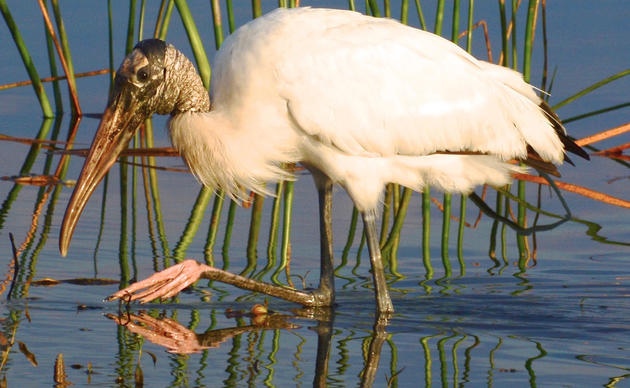Ground-breaking findings at Audubon’s Corkscrew Swamp Sanctuary about ghost orchids and their pollination by moths has been published (September 6, 2019) in Scientific Reports, an open-access journal from the publishers of Nature.
“Publication in Scientific Reports means that our work on ghost orchids passed the test of rigorous review by technical experts,” said Sanctuary Director Lisa Korte, Ph.D. “We’re pleased to join the ranks of international scientists sharing their discoveries with the world. This publication highlights our openness to collaboration and credibility as a research lab.”
Link to the paper in Scientific ReportsThe Scientific Reports article follows a presentation at Corkscrew in July at which National Geographic explorers Mac Stone and Peter Houlihan revealed photographs showing a Fig Sphinx Moth (Pachylia ficus) pollinating Corkscrew’s legendary “Super” Ghost Orchid. Before their discovery, scientific conjecture had long held that only the Giant Sphinx Moth (Cocytius antaeus) could pollinate ghost orchids due to the extreme length of its proboscis. Their photographs suggest that other hawkmoths with proboscis shorter than the Giant Sphinx Moth might also be able to pollinate ghost orchids. Stone and Houlihan, co-authors of the Scientific Reports paper, also photographed a Giant Sphinx Moth visiting the “Super” Ghost Orchid to feed but not necessarily functioning as a pollinator, leading to the hypothesis that Giant Sphinx Moths could actually be ghost orchid nectar robbers.
“Corkscrew Swamp Sanctuary protects a slice of Wild Florida that is increasingly rare as development continues throughout our state. Discoveries like this, a discovery that turns our understanding of how things work upside-down, highlight how truly important it is for us to conserve these ecosystems,” said Shawn Clem, Ph.D., one of the paper’s authors and Research Director of Audubon Florida's Western Everglades Research Center located at Corkscrew.
The photos were taken using a novel camera system nicknamed “TreePod.” In July 2018, Stone and Houlihan scaled the towering bald cypress tree where the “Super” Ghost Orchid is located and positioned the custom camera housing with an infrared motion detector that captured the nocturnal pollination. Their findings remained secret while the scientific paper was being reviewed.
"This effort not only fundamentality changes the long-accepted theory about ghost orchid pollination, it reminds us that we still have so much to learn about our backyard wildernesses,” said Stone, whose camera took the historic photos.
In addition to Stone, Houlihan and Dr. Clem, authors of the Scientific Reports paper were Mike Owen, biologist at Fakahatchee Strand Preserve State Park; and the late Thomas C. Emmel, Ph.D., founding director of the Florida Museum's McGuire Center for Lepidoptera and Biodiversity at the University of Florida.
"I'm extremely proud of our team and heartened by the possibilities when science, art and an esteemed conservation organization like Audubon work together,” Stone said. “Through imagery, my goal is to inspire the public and help deepen our relationship with nature, but it is a rare privilege when photographs can help move the scientific needle and actually change our understanding of the world."
The authors suggest that their findings have “broader implications for the conservation of an endangered species, orchids globally, and the importance of Everglades restoration.”
The paper highlights increased risk for ghost orchids with water loss from regional land use changes, and notes: “Small and large scale wetland restoration projects within the Greater Everglades can help maintain and restore climatic stability for both ghost orchids and their hawkmoth pollinators.” Wetlands restoration is one of the ongoing conservation projects at Audubon’s Corkscrew Swamp Sanctuary.
The study also calls for elevating protection of ghost orchids from state to federal status, saying that “poaching, historical logging, sprawling development and habitat degradation, and climate change” all threaten the existence of ghost orchids.
Corkscrew’s “Super” Ghost Orchid was discovered in 2007 by visitors searching for owls. Since then it has attracted thousands of visitors worldwide. This orchid is unique among ghost orchids as it is the largest and most prolific flowering ghost orchid known to exist, once producing more than 40 flowers in a season. It also grows higher than any other and had the earliest known flowering, producing blooms in January in 2015.
This year, the “Super” Ghost Orchid produced its first flower on June 27 and has remained in bloom since. Because it is 100 feet off the boardwalk and 50 to 60 feet up in an ancient bald cypress tree, it is difficult to see with the naked eye or even photograph with a standard lens. Corkscrew has positioned a spotting scope on the boardwalk for the public to view the flowers. Visitors are encouraged to bring binoculars or a camera with a powerful lens. Corkscrew rents binocular for $3.
The Sanctuary is open daily every day of the year from 7 a.m. until 5:30 p.m. with the last admission at 4:30 p.m.




